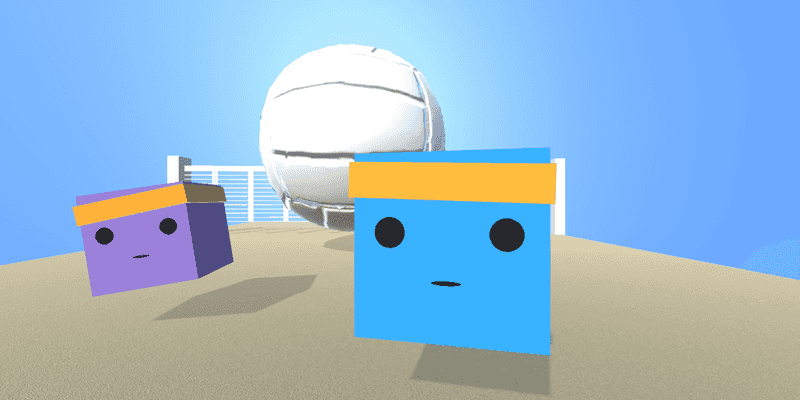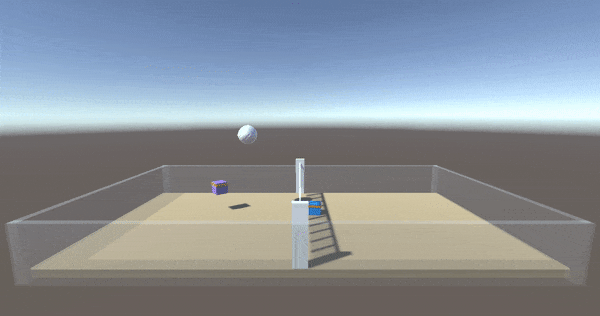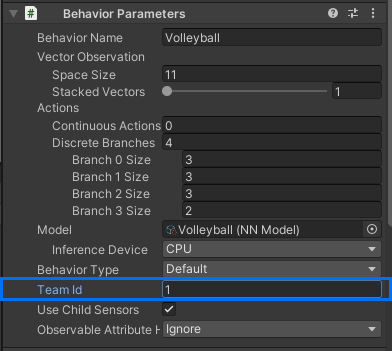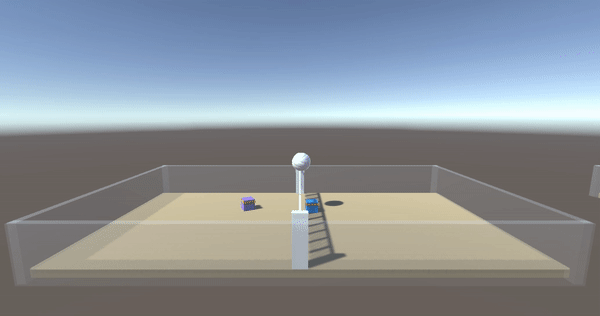Contents
All blogs / Competitive self-play with Unity ML-Agents
Competitive self-play with Unity ML-Agents
October 22, 2021 • Joy Zhang • Tutorial • 4 minutes

An overview of self-play
Competitive self-play involves training an agent against itself. It was used in famous systems such as AlphaGo and OpenAI Five (Dota 2). By playing increasingly stronger versions of itself, agents can discover new and better strategies.
In this post, we walk through using competitive self-play in Unity ML-Agents to train agents to play volleyball. This article is also part 5 of the series 'A hands-on introduction to deep reinforcement learning using Unity ML-Agents'.
Sections
- Part 1: Getting started with Unity ML-Agents
- Part 2: Build a reinforcement learning environment using Unity ML-Agents
- Part 3: Design reinforcement learning agents using Unity ML-Agents
- Part 4: Training an agent using PPO with Unity ML-Agents
- Part 5: Self-play with Unity ML-Agents (this post)
The case for self-play
We previously trained agents using PPO with the following setup:
- Symmetric environment
- Both agents shared the same policy
- Observations: velocity, rotation, and position vectors of the agent and ball
- Reward function: +1 for hitting the ball over the net
This resulted in agents that were able to successfully volley the ball back-and-forth after ~20M training steps:

You can see that the agents make 'easy' passes by aiming the ball towards the centre of the court. This is because we set the reward function to incentivize keeping the ball in play.
Our aim now is to train competitive agents that are rewarded for winning (i.e. landing the ball in the opponent's court). We expect this will lead to agents that learn interesting strategies and make passes that are harder to return.
Self-play setup in ML-Agents
To follow along this section, you will need:
- Unity ML-Agents Release 18+ (getting started instructions)
- The latest version of the Ultimate Volleyball repo (or, you can use your own volleyball environment if you've been following the tutorial series)
Step 1: Put the agents on opposing teams
- Open the Ultimate Volleyball environment in Unity
- Open Assets > Prefabs >
2PVolleyballArea.prefab - Select either the
PurpleAgentorBlueAgentobject - In Inspector > Behavior Parameters, set
TeamIdto 1 (the actual value doesn't matter, as long as the PurpleAgent and BlueAgent have different Team ID's):

Step 2: Set up the self-play reward function
Our previous reward function was +1 for hitting the ball over the net.
For self-play, we'll switch to:
- +1 to the winning team
- -1 to the losing team
- Open
VolleyballEnvController.csand add the rewards to theResolveEvent()method:
case Event.HitBlueGoal:
// blue wins
blueAgent.AddReward(1f);
purpleAgent.AddReward(-1f);
// turn floor blue
StartCoroutine(GoalScoredSwapGroundMaterial(volleyballSettings.blueGoalMaterial, RenderersList, .5f));
// end episode
blueAgent.EndEpisode();
purpleAgent.EndEpisode();
ResetScene();
break;
case Event.HitPurpleGoal:
// purple wins
purpleAgent.AddReward(1f);
blueAgent.AddReward(-1f);
// turn floor purple
StartCoroutine(GoalScoredSwapGroundMaterial(volleyballSettings.purpleGoalMaterial, RenderersList, .5f));
// end episode
blueAgent.EndEpisode();
purpleAgent.EndEpisode();
ResetScene();
break;- Remove
AddRewardfrom the other cases - You can also set penalties for hitting the ball out of the court (in
case Event.HitOutOfBounds). From my experience, this may take longer for the agents to learn to hit the ball.
Step 3: Add self-play training parameters to the trainer config
Create a new .yaml file and copy in the following:
behaviors:
Volleyball:
trainer_type: ppo
hyperparameters:
batch_size: 2048
buffer_size: 20480
learning_rate: 0.0002
beta: 0.003
epsilon: 0.15
lambd: 0.93
num_epoch: 4
learning_rate_schedule: constant
network_settings:
normalize: true
hidden_units: 256
num_layers: 2
vis_encode_type: simple
reward_signals:
extrinsic:
gamma: 0.96
strength: 1.0
keep_checkpoints: 5
max_steps: 80000000
time_horizon: 1000
summary_freq: 20000
self_play:
window: 10
play_against_latest_model_ratio: 0.5
save_steps: 20000
swap_steps: 10000
team_change: 100000Explaining self-play parameters
During self-play, one of the agents will be set as the learning agent and the other as the fixed policy opponent.
Every save_steps=20000 steps, a snapshot of the learning agent's existing policy will be taken. Up to window=10 snapshots will be stored. When a new snapshot is taken, the oldest one is discarded. These past versions of itself become the 'opponents' that the learning agent trains against.

Every swap_steps=10000 steps, the opponent's policy will be swapped with a different snapshot. The snapshot is sampled with a probability of play_against_latest_model_ratio=0.5 that it will play against the latest policy (i.e. the strongest opponent). This helps to prevent overfitting to a single opponent playstyle.
After team_change=100000 steps, the learning agent and opponent teams will be switched.
Feel free to play around with these default hyperparameters (more information available in the official ML-Agents documentation).
Training with self-play
Training with self-play in ML-Agents is done the same way as any other form of training:
- Activate the virtual environment containing your installation of
ml-agents. - Navigate to your working directory, and run in the terminal:
mlagents-learn <path to config file> --run-id=VB_1 --time-scale=1
- When you see the message "Start training by pressing the Play button in the Unity Editor", click ▶ within the Unity GUI.
- In another terminal window, run
tensorboard --logdirresults from your working directory to observe the training process.
Self-play training results
In a stable training run, you should see the ELO gradually increase.
In the diagram below, the three inflexion points correspond to the agent:
- Learning to serve
- Learning to return the ball
- Learning more competitive shots

Compared to our previous training results, I found that even after ~80M steps, the agents trained using self-play don't serve or return the ball as reliably. However, they do learn to hit some interesting shots, like hitting the ball towards the edge of the court:

If you discover any other interesting playstyles, let me know on Twitter!
Wrap-up
Thanks for reading! I hope you found this series useful.
Feel free to post any questions or feedback on the Ultimate Volleyball Repo.
If you're looking for further resources on reinforcement learning, check out:
